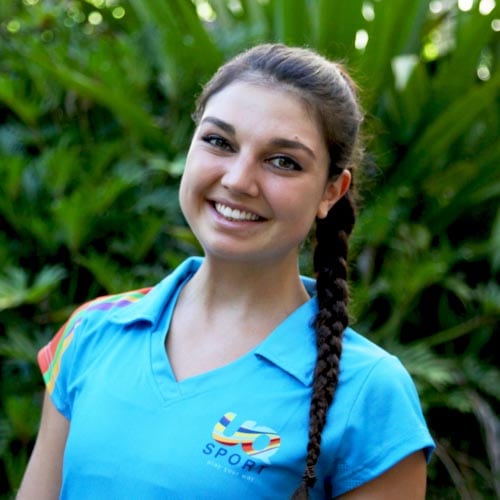There are few things in the world that we can never be sure of. You’ll probably always cry at the end of My Girl, if you’re soaking wet there’s a 30% chance it’s raining, and Kanye West may or may not run for president in 2024.
But there’s one thing we know for sure – the only true love/hate relationship is with a personal trainer.
We love ‘em because they motivate us to get out of bed at 5am but we hate ‘em when burpees, squat jumps and sprints are first up on the workout menu. But how can we REALLY hate ‘em when they inspire our fitness journey, and inch us closer and closer to our goals with every lunge?
PT’s are a wealth of health and fitness knowledge – they are walking encyclopaedias of physiology, anatomy and nutrition. Which is why when we’re scratching our heads about whether to eat a banana or a protein bar post-workout, we turn straight to our PT posse.
We picked our PT’s brains for answers to your commonly asked questions so you can work out with confidence! Meet your new workout buddies – John, Adam, Tyarra, Ryan and Sam.
JOHN YANG, EXERCISE PHYSIOLOGIST

Q: How do I become more muscular?
A: The short answer? Amp up the weights in your core exercises, such as your squats, bench press and chin-ups. The long answer? Every muscle fibre can produce force and each muscle is made of hundreds of thousands of muscle fibres. When these fibres grow bigger, they get stronger, so in turn when you get stronger, your muscles will grow bigger in order to lift heavier weight. You will rarely see someone who can bench 1.5x their body weight with a small chest.
Q: How do I get fitter?
A: First of all, everyone has a different concept of what is considered “fit”. In this case, I will assume cardiorespiratory or aerobic fitness. A very simple strategy is to start slow and build it up. For example, start lightly jogging at 7.5-8.0km/hr for 20 minutes and increase by 0.1km/hr per session. In 10 exercise sessions you would have increased your running speed (aerobic fitness) by 1km/hr!
Q: I have an injury, can I still exercise?
A: I recommend you always consult with your medical professional before beginning any exercise program. If they clear you to exercise, the next step is to consult with a fitness professional. We can then teach you exercises that won’t exacerbate your injuries. For example, a trainee may still able to work the upper body if they have an injured lower limb, and vice versa.
Q: How many times should I exercise per week?
A: The Australian Physical Activity guidelines recommend all adults to accumulate 150-300 minutes of exercise per week in order to stay healthy, and spend at least two days per week performing weights/resistance exercises. To increase strength and fitness, research suggest a minimum of three days per week. For weight maintenance, the general stance is 150-200 minutes per week and for weight-loss it is 300 minutes of accumulated exercise per week.
ADAM WREN, PERSONAL TRAINER

Q: What is meant by “turn on your core”?
A: “Core” as a term encompasses the muscles and connecting structures surrounding the lower half of the torso, from the diaphragm to the pelvic floor – picture it like a cylinder surrounding your lower back. Making up the outside of this ‘cylinder’ are all the muscles we are quite familiar with (the most common being your ‘abs’) in addition to those that lie deeper beneath the skin and are often taken for granted. These are called the transverse abdominis, the multifidus and the pelvic floor, and are the powerhouse muscles your trainer is referring to.
When asked in a training session to “turn on your core”, the answer is not a one size fits all. The term is relative to the activity you are about to perform and can range from lightly drawing in your stomach, to forcefully bracing. Finding the appropriate activation is important and may assist in increasing physical performance, as well as reducing the severity and incidence of lower back pain.
TYARRA NELSON, PERSONAL TRAINER

Q: If I am a girl, should I avoid lifting heavy weights so that I don’t get too muscly?
A: I cannot stress enough that women who lift weights will never be able to build a muscular physique that resembles that of a man. Essentially, this all comes down to the two hormones testosterone and oestrogen. Both hormones are responsible for building bone density and mass, however testosterone is primarily responsible for muscle protein synthesis, whereas oestrogen promotes fat deposition around the hips and the thighs – thanks for that, Mother Nature!
Quite simply, women do not have the levels of testosterone to build huge, bulging muscles and maintain a 4% body fat percentage like some men do. For a woman to build muscle, adequate nutrition, discipline and persistence in the weights room is required.
Long story short – weight lifting is awesome, it takes persistence, dedication, and ridiculously hard work, but it’s fun, challenging, and oh so rewarding. As a woman, don’t be scared to feel sexy, strong, and confident!
Q: I've been following the same gym routine to the point where I'm bored and have lost all motivation to exercise - how can I get my motivation back?
A: To achieve any goal in life, whether it’s fitness-related or not, maintaining motivation is absolutely essential. If you’ve hit a plateau and have lost your motivation to exercise, here are a few tips that can encourage you to get excited about being active again:
- Make a new music playlist that’s upbeat and will have you dancing between sets
- Go freestyle and wander around your gym, picking 5-8 machines you’ve never used before, and do four sets of 10 reps on each with 45 seconds rest
- Try training with a friend and following their session routine (you might pick up some new exercise ideas!)
- Pick 5-8 of your favourite upper and lower body exercises and train your full body
- Perform your regular gym routine backwards
- Do a fitness class you’re never tried before, like a yoga class or boxing lesson
- Spoil yourself and buy some new active wear
- Take your workout outside! Head to the beach, the park, or a nice spot by the river with a skipping rope and some resistance bands to workout in the sunshine!
Q: Are squats the only exercise that help to build your butt?
A: The answer is no! In fact, it’s quite possible to give Nikki Minaj a run for her money without doing a single squat in your life. Yes, squats are an excellent compound movement which majorly assist in building your glutes, however there are a wide range of exercises that are just as, if not more effective, at targeting your gluteal muscles.
Try barbell hip thrusts, cable kickbacks, wide-stance leg press, traditional and straight-leg deadlifts, box jumps or kettlebell swings, just to name a few… So not to worry, if squats cause you discomfort or are simply not your forte, you are still fully capable of growing your butt without droppin’ it low.
Q: What is the best exercise for weight loss?
A: Weight loss is completely attributed to energy expenditure vs energy consumption. At the gym, the amount of energy you burn will come down to the frequency, intensity, time, and type of exercise you are doing. The best way to burn more energy is to manipulate these factors with whichever type of exercise you choose to do – whether it’s cardiovascular or resistance-based. This means challenging yourself by decreasing the rest time, and increasing sets, weight, distance, or the number of times you exercise per week.
The best exercises for overall health are those that increase your strength and aerobic fitness simultaneously, such as HIIT or circuit training. This is because this form of training incorporates both cardiovascular and resistance exercises, such as squats, shoulder press, walking lunges, and skipping, in a way that will get your heart racing.
However, if this style of training is not for you, put an emphasis on resistance training with moderately heavy weights when you’re in the gym, and increase your cardiovascular fitness outside of the gym by walking more, taking the stairs, and doing activities on your feet. Both types of training will complement one another and you’ll achieve an incredible level of fitness, so that when someone asks you to do something physically enduring, the first thing you’ll have to question is your availability, not your capability!
RYAN BAILEY, PERSONAL TRAINER

Q: When should I stretch?
A: Daily. It’s one activity which I guarantee we don’t do enough of. Most people have the thought that stretching before and after exercise is the only time we should stretch.
The ‘tightness’ you often feel post-workout is a result of resistance and strength training that shortens our muscle fibres. To combat the muscle shortening and decreased range of motion through our joints, we lengthen them through some form of flexibility training, like stretching. My top tip? Don’t just stretch for the sake of stretching, but have a purpose. If you know you are particularly tight, or have overactive muscles, then this should be your target area.
Q: I want to incorporate more cardio into my workout routine, but I’m worried it might depleted my muscle mass. Am I worrying about nothing?
A: Cardiovascular exercise, or ‘cardio’, is one of the most effective ways to utilise oxygen to burn fat. Yes, if you’re in a calorie deficit (burning more calories than what you’re consuming), then it will damage your muscle mass as your body searches for an easy source of food. It’s all a matter of timing and intensity. There are two types of cardio I recommend:
- Fasted cardio: In the morning, your body is depleted with sugar and carbohydrates, so pounding the pavement in the morning before breakfast effectively burns fat.
- Post-weight cardio: When you lift weights, you stay focused to lift in a controlled manner. This is when you burn your most efficient energy source, carbohydrates. After the weight session, your body will mainly burn fat!
Keen to find a fitness mentor among our PT posse? Find out more about our Personal Training packages to kick-start your fitness journey today.

